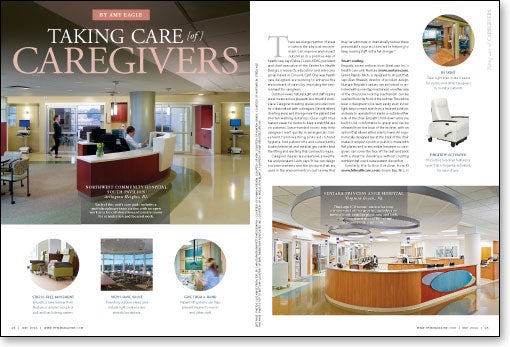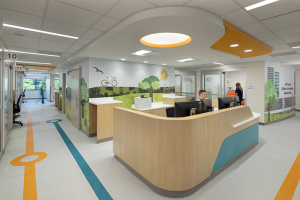Taking care of caregivers

Click the above image for a PDF download
There are a large number of areas in which the physical environment can improve and impact outcomes in a positive way in health care, says Debra J. Levin, EDAC, president and chief executive of the Center for Health Design, a research, education and advocacy group based in Concord, Calif. One way health care designers are working to enhance the environment of care is by improving the environment for caregivers.
Outdoor views, natural light and staff respite areas create a more pleasant, less stressful workplace. Caregiver meeting spaces provide room for collaboration with colleagues. Decentralized charting areas and storage near the patient bed shorten walking distances. Clear sight lines make it easier for nurses to keep a watchful eye on patients. Same-handed rooms may help caregivers react quickly in emergencies. Convenient hand-washing sinks aid in hand hygiene. And patient lifts and conveniently located electrical and medical gas outlets limit the lifting and reaching that can lead to injury.
Caregiver injuries are expensive, preventable and prevalent, Levin says. "If we can design our environments and the products that are used in the environments in such a way that they can eliminate or dramatically reduce these preventable injuries, then we're helping to keep nursing staff in the field longer."
Smart seating
Empath, a new recliner from Steelcase Inc.'s health care unit Nurture (www.nurture.com), Grand Rapids, Mich., is designed to do just that, says Alan Rheault, director of product design, Nurture. Empath's casters can be locked or unlocked with a one-step mechanism on either side of the chair; this locking mechanism can be reached from the front of the recliner. The recline lever is designed to be seen easily even in low light, easy to reach even from a reclined position, and easy to operate from inside or outside either side of the chair. Empath's fold-down arms are built to be comfortable to grasp and can be released from the back of the recliner, with an option that allows either side to lower. An ergonomically designed bar at the back of the chair makes it simple to push or pull. It is made with flat planes and a removable headrest so caregivers can cover the face of the seat and back with a sheet for cleanliness, without creating wrinkles that could cause patient discomfort.
Similarly, the Soltice II recliner from KI (www.kihealthcare.com), Green Bay, Wis., is designed with a foot-operated central locking and unlocking caster mechanism that is simple to understand. The recline lever is made to be fingertip-activated, for ease of use. The chair can rotate 360 degrees within its own footprint to fit into tight spaces; it also features a small, flat footrest that can slide away under the unit when not in use. Dual handles on the back of the recliner make it simple to move. An optional tablet arm, IV pole, catheter hook and magazine pouch are available. For products to be used in the patient room, KI is "always looking through the eyes of the nursing staff," says Debbie Breunig, the company's vice president of health care. An efficient, thoughtful environment helps with staff recruitment and retention, she says.
The sleepToo sofa sleeper from Weiland (www.wielandhealthcare.com), Grabill, Ind., combines a convertible sleep surface with a complete, compact family zone that includes an ottoman, in-unit storage and an adjustable table that can be shared by multiple people. The table meets the requirements of the Americans with Disabilities Act to be wheelchair-accessible, and the sofa's sleep surface conversion is pneumatically assisted. "It's a very intuitive product," says Karen Edmundson, furniture sales executive for Business Interiors by Staples (www.staplesadvantage.com/business-interiors/index.html), Framingham, Mass., a full-service provider of furniture and design solutions for organizations across industries, including health care. The sleepToo's design means nurses can spend less time assisting family members with furniture and bedding, and more time on direct patient care.
Computing and storage options
Edmundson also recommends the medical carts and wall computing stations made by Enovate (www.enovateusa.com), Canton, Mich. These products are designed to be comfortable to use in either a sitting or standing position. "As our record-keeping turns more and more to electronic medical records, the use of computer workstations is going to become more and more prevalent as part of charting and patient care. The more that we can create these workstations to be adaptable and ergonomic, the more we can prevent the injuries that come with neck and eye strain, and even things such as glare," says Levin.
Gary Cruce, design principal, Nemschoff Inc. (www.nemschoff.com), Sheboygan, Wis., a subsidiary of Herman Miller Inc. (www.hermanmiller.com), Zeeland, Mich., says the Oasis Overbed Table is designed to fulfill specific requests for features that support caregivers. "They're the people using the product on an everyday basis," he says. Cruce notes hospitals seem to be moving away from the use of bedside cabinets, and the Oasis Overbed Table is seen as a possible replacement for storing items previously kept at the bedside. Oasis has an easily accessible, plainly visible open tray design with dedicated space for patients and caregivers. Optional upper and lower trays increase storage space even more. A raised edge near the column not only contains items, it also allows caregivers to rest a clipboard over the top of small items without disturbing them.
The Compass System by Herman Miller Healthcare (www.hermanmiller.com/solutions/healthcare.html), another Herman Miller Inc. subsidiary, has new storage and lighting options designed with caregivers in mind. Lower storage units can be used to keep items near at hand in patient rooms, so nurses do not have to walk down corridors to retrieve pillows or other commonly used items. In a clinical setting, the unit can be used to store paper or pre-printed patient instructions. The cabinet doors swing out of the way on 170-degree hinges. Optional electrical power enables the installation of a fax machine or printer, while the back of the unit can be vented to allow heat to escape. The new above-bed light comes standard with settings for exam, ambient and reading light, with a variety of control options that allow the light to be operated from the entry, bedside or other convenient location.
"Caregivers are important. They're the lifeblood of the facility," says Kurt Kapp, senior product manager, Herman Miller Healthcare. "You want them to have the best possible experience with the product, because that makes them better at their jobs."




